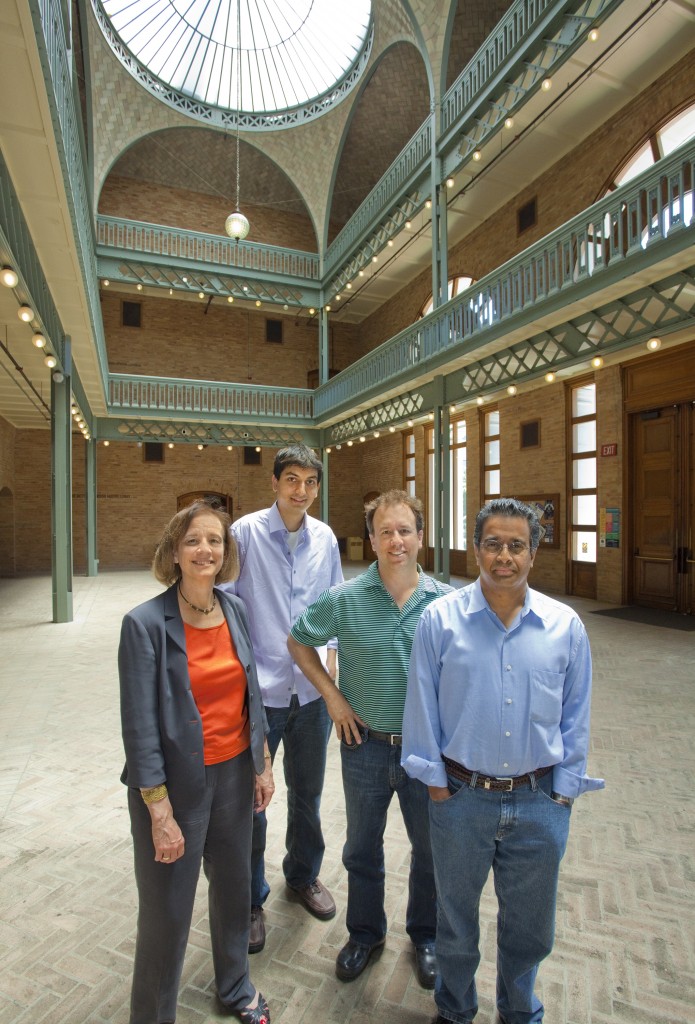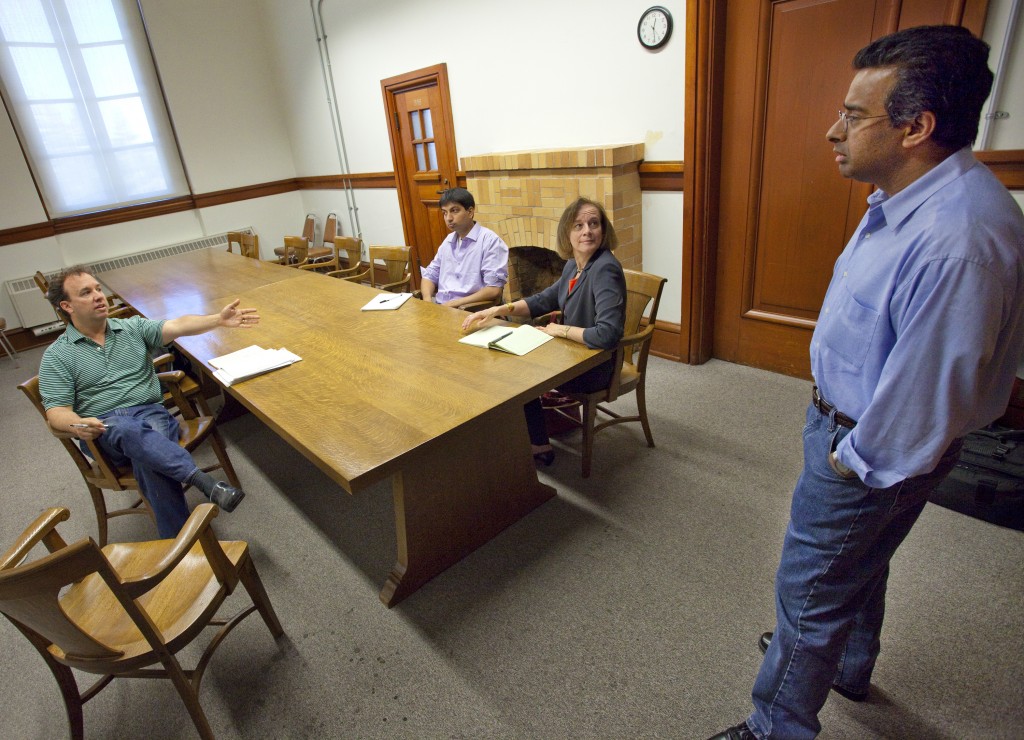Science can be a long, slow haul. The road to discovery is usually filled with endless experiments, much trial and error, reformulating of hypotheses, re-experimenting and, sometimes, a very lucky break. Contrast that with venture capitalism, generally a whirlwind of activity, marked with a rush to get a product to market, beat competitors and turn a profit. Can the two work together?
An innovative new program at the Lawrence Berkeley National Laboratory is proving they can, very well.
Since late last year Jim Matheson, a partner at VC firm Flagship Ventures, has been Berkeley Lab’s “entrepreneur in residence.” From his firm’s headquarters in Cambridge, Massachusetts, he travels to Berkeley monthly to meet with scientists and “add some commercialization impulse to the Lab,” as he puts it.

(from left) Cheryl Fragiadakis of Berkeley Lab's Tech Transfer Department, Devesh Khanal (a Ph.D. candidate working with Flagship), Jim Matheson of Flagship Ventures and Berkeley Lab scientist Ramamoorthy Ramesh (photos by Roy Kaltschmidt/ Berkeley Lab Public Affairs)
The Department of Energy (DOE)’s Office of Energy Efficiency and Renewable Energy started the EIR program two years ago to accelerate the deployment and commercialization of advanced clean energy technologies from the national laboratories. In the first year, three VC firms were paired with three national labs. The following year, five more firms were each paired with a national lab, including Berkeley Lab.
While it’s too early to quantify the results of the program—as Matheson is just past the halfway point of his yearlong residence at Berkeley Lab—participants agree that it has been immensely valuable.
“It’s fantastic,” says Berkeley Lab materials scientist Ramamoorthy Ramesh, who works on photovoltaics and has met with Matheson regularly. “I now have somebody interacting with me on a periodic basis. We cannot dictate when the research will take off. If we met a few metrics, he’s probably ready to turn on a tap. That’s useful for us in terms of me not having to go look for somebody.”
Like most large research universities and national laboratories, Berkeley Lab has a technology transfer office to help make sure that scientific innovations get into the marketplace, including filing for patents and negotiating licensing deals. But they don’t always have the time and resources to deliver all the support needed to launch a startup—or to determine if a startup is even viable.
“It has been valuable because unlike other visits from venture capitalists, there’s been a continuity with this program, so we’re getting some amount of perspective on our technologies, both in comparison with each other and with what else is out there,” says Cheryl Fragiadakis, director of Berkeley Lab’s Technology Transfer and Intellectual Property Management Department. “He has given us a broader look at the startup potential of a whole array of technologies in the cleantech space.”
Matheson has found a high level of entrepreneurial enthusiasm at Berkeley Lab. He and his Flagship colleagues have met with close to 100 scientists so far, and now are focusing on how to move forward with a small number of them. He has also held office hours and a couple informal lunch sessions, which Fragiadakis hopes will be the start of a more formal education program.
“We’d like to do something to educate our scientific staff on the entrepreneurial world that is a little more structured, more data rich—what’s expected, key elements of success,” she says, “to make it that much easier to move their technologies out to the private sector if and when they decide to do so.”
The only complaint—by all parties—is that the one-year EIR program is not long enough to really accomplish anything. “We’ve suggested to DOE, as have other labs, that one year is probably too short because a lot of technologies have long development timelines,” Fragiadakis says.

Matheson, Khanal, Fragiadakis and Ramesh (from left) meet to discuss technology commercialization possibilities.
Since 1990, technology developed by Berkeley Lab scientists has helped launch nearly 30 start-up companies, including Solexant (solar cells), Soladigm (“smart” glass) and PolyPlus (batteries). “Our hope is to go from an average of two startups a year to many more a year because of this program, either ones the EIR will bring investment to directly, or just might help us evaluate and tee up for someone else to invest in,” says Fragiadakis.
Flagship is an especially good fit for Berkeley Lab, according to Matheson, because of its distinctive way of doing business. “We like to consider ourselves a VC and entrepreneurial firm, focused on early-stage efforts in healthcare and sustainability arenas, the life sciences and physical sciences,” he says. “We’re relatively unique in that a full one-third of companies we’re involved in are ones we’ve started, even as high as 40 percent. We actually have a committed practice to starting companies—not incubating, but rather starting companies.”
Still, the science agenda of the national laboratories does not always fit well with market demands. “The research work there, by the nature of the mission, is usually not being done with a commercial orientation, thinking about how technology might apply in a commercial setting and showing how it’s scalable,” Matheson says. “There are significant technical risks in proving that scale-up, and those things generally aren’t tackled at the Lab. Also, the way the projects are funded, researchers will do great work but will have to end abruptly because the funding has ended and so they have to move onto the next project. There’s no ability to continue pursuing the project and move it towards maturity.”
Perhaps confirming that scientists are not money-minded, Ramesh argued that Flagship should consider investing less money. “When things are more serious, Flagship puts in $1 million, but what about slightly below that: make a $200,000 investment to make the point,” he says, then explains: “For us, it would speed up processes. Progress is painfully slow because everything is serial. But if you had some intense engineering people who could take ideas and put a tight spin on it, that would be valuable.”